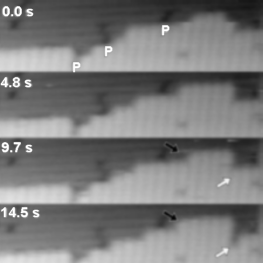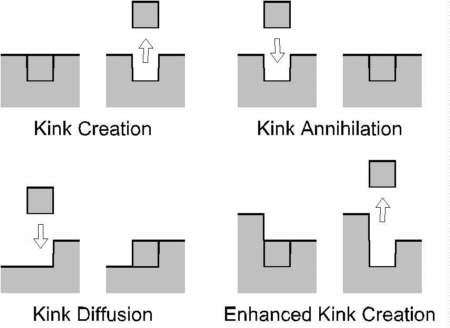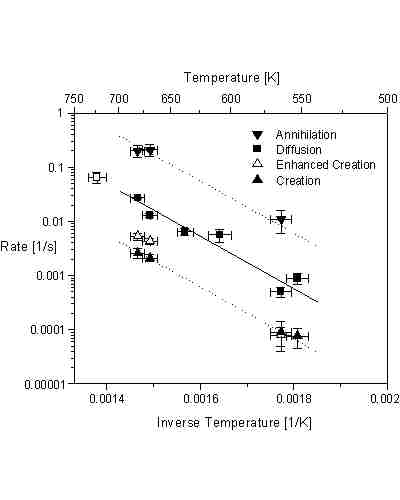 |
We used an STM to study the dynamics of step edges on the Si(001)-(2 × 1) reconstructed surface at temperatures from 520 to 700 K [Pearson 1995a,b]. At these temperatures, surface diffusion is too fast to image using conventional STM, so instead we studied the changes in step edges, which reflect the results of surface mass diffusion. By making images at the appropriate rate, individual step edge events are resolved. Fig. 2 shows a typical short sequence from long movies of type-B step edges at elevated temperatures.
 |
FIG 2. Four subsequent 220 × 55 Å STM strip images of the Si(001)-(2 × 1) surface at 682 K. The images show kink enhanced kink creation (white arrows) and kink diffusion (black arrows) on a Sb step edge. The surface steps down from the lighter to the darker terrace. The elapsed time at the start of each scan is shown. Pinned sites are marked with P's in the first image.
Individual attachment and detachment events are observed to occur in units of four Si atoms (two dimers at this temperature). We counted changes in step edge position as a function of step edge configuration to determine the rates of the various processes. Four of the important processes are shown schematically in Fig. 3. By amassing data over a range of sample temperatures, we can construct an Arrhenius plot, as shown in Fig. 4.
 |
FIG 3. Schematic diagram showing step edge events. Creation events are relatively rare and are usually followed by an annihilation event. Diffusion events are the dominant process on the surface.
 |
FIG 4. Arrhenius plot for four kink processes.
From the Arrhenius plot, we find the effective activation energy for kink diffusion to be 0.97 ± 0.12 eV with a prefactor of 3 × 105 Hz. Kink diffusion is the dominant process, although the creation of kinks can also be an important rate limiting step in step flow. Together, these processes control the rates of surface mass transport at these temperatures, as material must first escape from a step edge and then travel to another step edge.